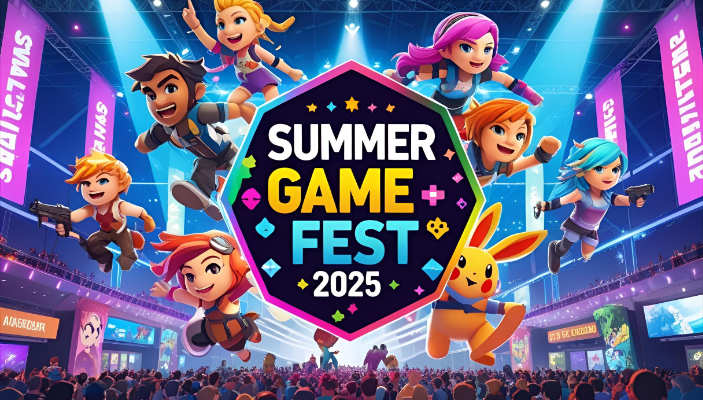Summer Game Fest 2025 has taken its place as one of the most influential global events in gaming. From high-profile game reveals to developer panels and exclusive hands-on demos, this year’s edition brought forward a people-first presentation style, focused on delivering excitement without hype fatigue. This in-depth overview highlights the biggest announcements, meaningful trends, and what gamers can expect moving forward.
What is Summer Game Fest?
Summer Game Fest is an annual digital-first showcase founded by Geoff Keighley. It started in 2020 as an alternative to the traditional in-person expos and has now evolved into a major destination for game publishers, developers, and fans worldwide.
Unlike single-company showcases, SGF brings together announcements from multiple studios and platforms—creating a unified space for global engagement. SGF 2025 once again streamed live across Twitch, YouTube, and major social platforms, with co-streaming partnerships from content creators around the world.
Headliners: Major Games That Took Center Stage
Grand Strategy Meets Fantasy: Elder Empires: Rise of Dawn
From Paradox Interactive, this highly anticipated title blends 4X gameplay with branching narratives. Players shape political alliances, lead hybrid armies, and influence historical lore in real-time.
Open World Innovation: Project NEXUS
A standout from Square Enix, Project NEXUS features procedurally evolved landscapes that adapt to player decisions. Built using Unreal Engine 5.3, the demo demonstrated dense foliage, hyperrealistic physics, and new AI ecosystem behaviors.
Multiplayer Spotlight: Fractured Realms
Ubisoft revealed a co-op RPG where four players travel across multi-layered dimensions. Emphasis was placed on emotional storytelling, community-based design feedback, and cross-platform save progression.
Indie Highlights That Surprised Everyone
Before the Ashes
Developed by Emberloop Studios, this quiet indie thriller captivated audiences with its minimalist design, evocative soundtrack, and real-time weather effects. A narrative-driven experience focusing on memory, trauma, and resilience.
Slumber City
A surreal city-builder where players manage the dreams of sleeping citizens. Slumber City mixes management simulation with light rhythm mechanics. Players must tune ambient frequencies to prevent “dream erosion.”
Evolving Game Technology in 2025
Procedural Audio and Dynamic Environments
Games like Project NEXUS and Slumber City showcased advanced procedural audio systems. These adapt to emotional cues, ambient noise, and in-game triggers—blending player input with environmental realism.
AI Collaboration in Game Design
Developers at SGF discussed how generative AI tools are assisting (not replacing) artists, animators, and narrative designers. From generating concept art to auto-balancing combat mechanics, AI is accelerating iteration cycles while keeping human creativity at the center.
Real-World Integration and Augmented Gaming
Mixed Reality in Fusion Field
HoloArts debuted Fusion Field, a multiplayer AR battle game that overlays competitive arenas in real-world spaces. Using LiDAR-based mapping and real-time occlusion, it blends gaming with physical environments without needing a headset.
Smart Controller Feedback
A panel led by Sony and third-party hardware makers explored new haptic technologies. Upgraded adaptive triggers, scent diffusion, and customizable thermal responses provide players with tactile storytelling—a leap forward from static vibrations.
Representation and Diversity in Games
Spotlight on Inclusive Storytelling
Studios like GlowForge and Narrative North presented titles with culturally specific storytelling, multilingual dialogue support, and accessibility-first design.
Examples include:
- Roots of Kinship: A branching story game centered around an Indigenous Australian family over three generations.
- Neon Choir: An Afrofuturist rhythm RPG where music and movement define character growth.
Big Publisher Announcements
Xbox Showcase: Game Pass Expands
Microsoft revealed 11 new Game Pass titles launching simultaneously on cloud, console, and PC. This includes Saberlight, World Beyond Iron, and Moonveil 2. The event also teased a redesigned Xbox interface with integrated community mod-sharing features.
PlayStation’s Developer Direct
Sony focused on first-party titles such as ChronoSentience and DreamWeaver. These titles emphasize storytelling, single-player immersion, and a return to complex branching quests—providing balance against live service fatigue.
Behind the Scenes: Developer Panels Worth Noting
Building Games That Last
From Larian Studios to ConcernedApe (Stardew Valley), the common theme across developer talks was player-centric design. Developers highlighted building long-lasting communities through transparency, early testing, and social listening.
Mental Health in Game Development
Several developers emphasized healthier production environments. The SGF Mental Health Lounge, hosted by Safe In Our World, provided open forums on managing stress, burnout, and remote collaboration.
The Audience Experience: A Community-Driven Festival
Interactive Show Elements
For the first time, fans voted live on which demos should receive extended gameplay slots. Twitch integration allowed viewers to rate trailers, submit questions for panels, and even earn cosmetic items in partner games.
Fan Art and Cosplay Showcases
Over 50,000 fan art submissions were received through the SGF portal. Finalists were featured live during intermissions, with community votes determining the winners in real time.
Key Takeaways from SGF 2025
- Games are getting smarter, not just prettier – More emphasis is being placed on systems design, procedural input, and community evolution.
- Human stories lead the way – Diverse voices, accessibility, and emotional depth are becoming the new standard in successful storytelling.
- Technology is enhancing connection – From AI-driven co-op mechanics to mixed reality gameplay, the tools are expanding the experience, not replacing the player.
Anticipated Releases Announced at SGF 2025
| Game Title | Publisher | Expected Release |
|---|---|---|
| Project NEXUS | Square Enix | Q1 2026 |
| Elder Empires | Paradox Interactive | Holiday 2025 |
| Fusion Field | HoloArts | Beta Late 2025 |
| Roots of Kinship | Narrative North | Spring 2026 |
| Fractured Realms | Ubisoft | October 2025 |
The Future of Gaming Events
Summer Game Fest 2025 proved that community-first content, hybrid delivery formats, and developer transparency are now central to a game event’s success. With E3 now fully defunct and individual studio showcases fragmenting, SGF’s unified model of celebration, collaboration, and commentary is setting a new benchmark.
Whether you’re a casual player, game designer, or esports enthusiast, SGF provided a cross-section of gaming’s future that speaks to both passion and progression.
5 Short FAQs
Q1. When did Summer Game Fest 2025 take place?
A: It was held from June 5 to June 9, 2025, with global livestreams and in-person media demos.
Q2. Who hosted Summer Game Fest 2025?
A: The event was hosted by Geoff Keighley, along with co-hosts from major gaming platforms and creators.
Q3. What made SGF 2025 different from past years?
A: Greater focus on playable demos, interactive viewer options, and increased emphasis on representation and AI-powered game tools.
Q4. Will the announced games be platform-exclusive?
A: Most titles support cross-platform releases, though some remain exclusive to Xbox, PlayStation, or PC initially.
Q5. Can I rewatch SGF 2025 panels or trailers?
A: Yes, full replays are available on YouTube, Twitch, and the official Summer Game Fest website.




![Martha Stewart Style Rises in 2025 [Modern Aesthetic Trends]](https://blogss.online/wp-content/uploads/2025/07/Martha-Stewart-Style-Rises-in-2025-Modern-Aesthetic-Trends.png)

![7 AI Trends for 2025 Businesses Must Track [AI Strategy]](https://blogss.online/wp-content/uploads/2025/07/7-AI-Trends-for-2025-Businesses-Must-Track-.png)

[…] Summer Game Fest 2025 […]